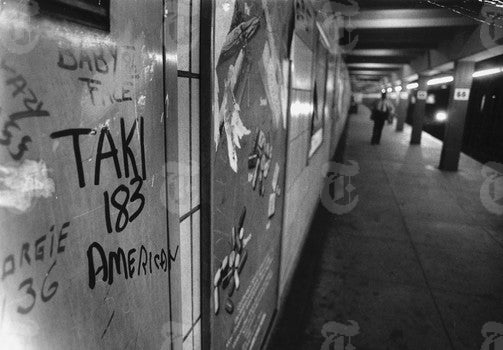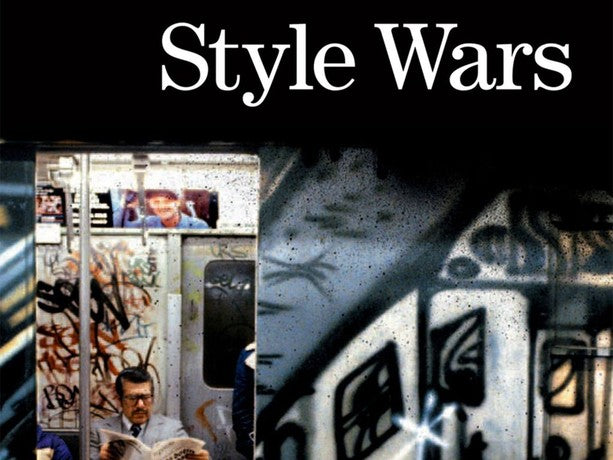Though all five of New York City’s boroughs – Manhattan, Brooklyn, Queens, the Bronx, and Staten Island – became laden with graffiti by the early 1980s, it is Manhattan’s Washington Heights neighborhood that lays claim to starting it all. Greek-American graffitist TAKI 183 began tagging walls with his nickname in the 1970s. His tagging, coupled with the city’s economic downturn and rising crime rates, spawned a new crop of street artists responsible for a decade-long wave of graffiti art that hit all parts of New York City. By the mid 1980s, with police and government officials eager to squash what they saw as property defacement, many artists found success in the rising East Village gallery scene or with commissioned public art.

Daze, Crash, Lady Pink, and Basquiat make their mark on the scene
While countless unnamed writers contributed to the spread of graffiti across New York City, many writers quickly established an original style and language that lifted them above the rest.

In Brooklyn and the Bronx, young graffiti writers Daze and Crash would meet up after school and finagle access to tunnels throughout the city, some of which housed pristine metal subway cars just asking to be tagged, and some stocked with older cars revealing the spray-painted marks of writers before them. As some of the most prolific writers in New York City at the time, eventually adding hundreds of train cars in their portfolio, Daze and Crash later found fame as commissioned artists with gallery representation. Their experiences even inspired the recent Netflix series, The Get Down.

Lady Pink, an Ecuadorian-American whose family moved to Queens in the 1960s, began writing graffiti as a teenager attending an arts high school in Manhattan. At her high school she met tagger TC5 who, after much convincing, let her join his crew when they ventured out to the train yards. Her name was chosen by a crew member in large part to communicate that she was female – a unique characteristic among mostly male graffiti groups. She added the moniker Lady to suggest a level of refinement. In 1979, Lady Pink founded the Ladies of the Arts (LOTA) to collaborate with fellow female taggers. Though she spent five years tagging train cars, she eventually reduced her participation in the street scene in favor of the safer and more lucrative gallery scene.

In the East Village, artists like Jean-Michel Basquiat helped build that neighborhood’s stature as a hub for street artists turned gallery artists. Gary Indiana, filmmaker and former art critic for the Village Voice during the mid-80s, describes the area as “an ideal refuge for any artist born without a silver spoon” (nymag.com). Many of the galleries that popped up in the East Village provided structured opportunities for street artists – including Basquiat, Lady Pink, Keith Haring, and others – tired of evading the police.

Henry Chalfant: the man with the camera who captured it all
With street art mapping its presence across all of New York City, curious photographers and reporters had no shortage of content to investigate. In the late 1970s, Henry Chalfant, then transitioning from a career as a sculptor to one as a photographer and filmmaker, turned his 35mm camera toward the burgeoning street art scene after spying two subways cars painted by Lee Quinones and the Fabulous Five Crew.

In a recent interview with New York Times reporter Max Lakin, Chalfant recalls, “I found the contrast between what I was doing as a solitary studio artist and what I clearly need in my life, which was more engagement in the world, and this is how I found it” (nytimes.com). Chalfant would stand on subway platforms at times to capture photos of the trains speeding by, or routinely show up at the same locations to catch writers in the act.

As a white male in his forties, Chalfant had to earn the trust of the young writers he documented. He did. Writers whose works have long since disappeared – Blade, DAZE, T-Kid – now have their legacies preserved among the 1,500 photographs that Chalfant captured during his career.

A 2019 exhibition at the Bronx Museum of the Arts, “Henry Chalfant: Art Vs. Transit, 1977-1987,” includes life-size prints of the subway cars that Chalfant’s camera first captured over thirty years ago. According to writer Taylor Dafoe’s coverage of the exhibition, Chalfant’s workspace once served as a visual catalog of the latest work from the city, and artists would stop by to “pour through the photographer’s archive, comparing their work to that others” (news.artnet.com). As the de facto resource on graffiti art in the early 80s, Chalfant also helped expose graffiti art to new audiences through published books and documentaries. While Chalfant was the master of the still image, several films and television programs brought additional attention to graffiti art in its early 1980s heyday.

Graffiti films that helped educate the world beyond New York City
In 1983 alone, three films chronicling the hip hop scene – Breakin’ and Enterin’, Wild Style,and Style Wars – were released on a limited basis to a national audience. Similarly, films like Beat Street(1984) and Krush Groove (1985) also drew attention to the multi-faceted hip hop culture of the 1980s.

Charlie Ahearn directed Wild Style, the first hip hop film. Using the talents of Dondi, Zephyr, Revolt, and Sharp to create the film’s signature mural, Ahearn crafted what could be called a spontaneous blend of scripted narrative and documentary. Graffiti artist Lee Quinones takes the lead role, though other noted heavyweights from the era – Grandmaster Flash, Fab Five Freddy – make appearances. Aside from photographing the era, Chalfant produced Style Wars, a Grand Jury Prize winner at the Sundance Film Festival still revered today as the seminal hip hop film. Featuring street artists such as Dondi, Seen, Zephyr, and TAKI 183, the film contrasts perspectives from graffiti writers with those of New York City mayor Ed Koch.

In 1984, Graffiti Rock entered the small screen scene as an attempt at hip hop television programming. Graffiti artist Brim created the set, while The New York City Breakers, Run DMC, Kool Moe Dee, and others performed. While the program offered something distinct from other creative programs, such as Soul Train, and featured writers and performers from all of New York City’s boroughs, larger television markets in cities like Chicago and Los Angeles were reluctant to bite. Consequently, Graffiti Rock lasted only one episode, but still stands as an example of innovative programming aimed at bringing street art culture to wider audiences.

In 1985, when citywide graffiti clean-up efforts were on the rise, the film Turk 182 perpetuated a view of graffiti as a defiant, even political art form. Jimmy, the lead character in the movie, seeks personal vengeance against his corrupt mayor by tagging the very subway car that mayor touted as graffiti proof with, “Tyler Knew! Turk 182!” The film’s release came at a time when officials’ top priority was to scrub New York City clean of graffiti.

Conclusion
Each borough of New York City played host to bold artistic voices of in the early 1980s. Even as the authorities clamped down on street art’s presence by the mid 1980s, artists continued to infuse the city with their fresh perspectives and style.






Justin Carr
September 07, 2020
Wow I’ve never seen that (is it Seen,which one?) and Crash whole car,it’s dope AF